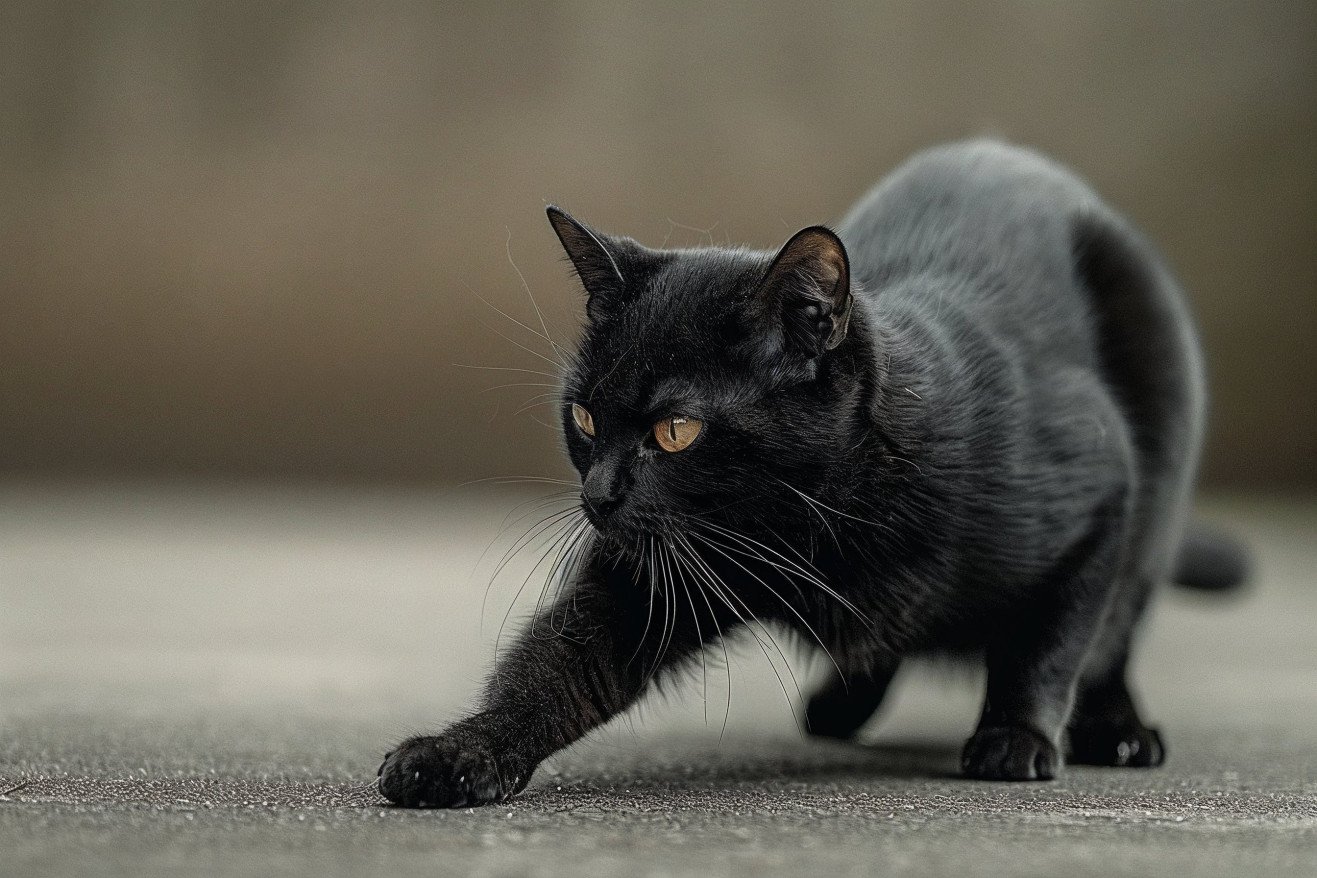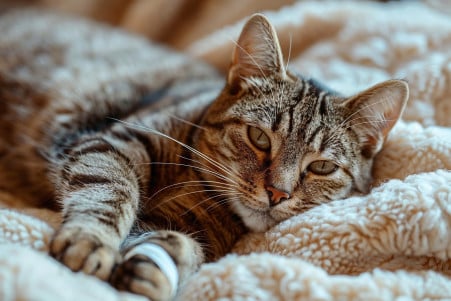Do Cats Have Knees? Exploring Feline Knee Joints and Agility
31 May 2024 • Updated 31 May 2024

While many people are familiar with the incredible agility of cats, especially when it comes to climbing and jumping, the same can't be said for the anatomy of their leg joints. Yet, cats have knees, it's just that their knee joints are less visible than those of humans and other larger animals. A cat's knee is a hinge joint that's made up of the femur, patella (kneecap), and tibia bones and enables the hind leg to bend and straighten.
This article will review the scientific literature on feline anatomy to explain the workings of the cat's knee joint and how it helps cats perform their amazing physical feats. Through a review of studies in the fields of veterinary medicine, biomechanics, and evolutionary biology, you'll learn about the special adaptations that make it possible for cats to move with such agility and grace. In addition, this knowledge will help you understand the knee problems that are most common in pet cats and the best ways to prevent them.
Do Cats Have Knees?
The Cat's Knee Joint: In-Depth
The cat's knee joint, also known as the stifle joint, is a hinge joint that is essential to the cat's ability to move with agility and land on its feet. The stifle joint is made up of three bones: the femur (thigh bone), patella (kneecap), and tibia (shinbone), as well as the ligaments, tendons, and cartilage that hold the joint together and enable movement.
A study published in PubMed found that the cat's knee joint is similar to the human knee joint in many ways, but the proportions of the bones and other structures are different. This difference in proportions is due to the fact that the cat's knee joint has evolved to meet the demands of a quadrupedal lifestyle and the need to jump with precision and power.
One of the adaptations that has evolved in the cat's knee joint is the arrangement of the collateral ligaments, which a study published in PubMed found are twisted in all but one of the positions it studied, the fibers in the meniscal part of the medial collateral ligament. This twisting of the fibers helps stabilize the joint while still allowing for the cat's acrobatic movements.
The patella, or kneecap, is an important part of the cat's knee joint, as it acts as a pulley for the quadriceps tendon and helps extend the cat's leg. However, as a study cited by Semantic Scholar explains, the patella is proportionally different in cats than in humans, which affects the biomechanics of the joint. This difference, along with the cat's lightweight, muscular body, helps the cat jump and land on its feet with precision.
Most Frequent Knee Injuries and Disorders in Cats
Cats can suffer from a number of knee injuries and disorders, but the most common are cranial cruciate ligament (CCL) rupture and patellar luxation. According to WagWalking, a CCL rupture can cause acute lameness, swelling, and pain in the affected hind leg. This injury is usually the result of trauma, such as the leg being caught or a fall, and is more likely to occur in overweight cats.
Meanwhile, Vetrix, Inc. notes that patellar luxation is another common knee problem in cats, which occurs when the kneecap moves out of its normal position. It can be present at birth or develop over time due to causes such as joint laxity and obesity. Symptoms include limping, stiffness, and difficulty extending the leg.
Diagnosis of these conditions typically includes a physical exam, x-rays, and possibly advanced imaging like an MRI, according to Joii Pet Care. Treatment can include conservative management with pain relief and physical therapy to surgery to stabilize the joint, according to Manchester Veterinary Specialists. Early treatment is important to avoid further joint damage and the development of severe arthritis.
How to Keep Your Cat's Knees Healthy
One of the most important things you can do to keep your cat's knees healthy is to keep your cat at a healthy weight. Obesity is a major risk factor for joint disease in cats, and, as Preventive Vet notes, fat cells are pro-inflammatory. Making sure your cat gets enough exercise and stays active can also help maintain joint health and mobility, especially since, as Pet Wellbeing explains, movement is necessary to keep joint fluid flowing and lubricating the joints.
In addition to these general measures, The Spruce Pets suggests making environmental modifications to ensure that your cat's living space is as joint-friendly as possible. This may include providing safe, stable climbing opportunities, comfortable beds, and non-slip surfaces to minimize the impact of repetitive stress on the joints. Nutritional support, including fish oil, omega-3s, glucosamine, and chondroitin supplements, may also be beneficial, according to Pet Wellbeing.
Finally, regular vet visits and monitoring are important for catching knee problems early, as Cornell University's Feline Health Center points out. Early treatment can prevent further damage to the joints and the development of arthritis.
Coping With Knee Issues in Older and Geriatric Cats
Older and geriatric cats are at an increased risk for knee issues and arthritis. In fact, according to Preventive Vet, almost 40% of all cats have arthritis, a degenerative joint disease that tends to get worse over time. In addition, the Pet Wellbeing article explains that by the time cats are 12 years old, 90% have bone changes associated with arthritis that can be seen on x-rays.
When the protective cartilage in the joints wears away, the bones start to rub together, which causes pain, inflammation, and a loss of mobility. The Wildest also points out that other issues such as traumatic injuries can impact older cats. It’s important to catch these issues early and manage them effectively to ensure a good quality of life.
Making changes to the home environment can make a big difference for older cats with knee issues. Preventive Vet suggests giving cats safe ways to climb, comfortable orthopedic beds, and non-slip surfaces to avoid repetitive stress on the joints. Pain management through medication, supplements, and alternative treatments such as acupuncture can also help, according to The Wildest.
In the end, a well-rounded plan that aims to maintain mobility and comfort is the best way to help older cats with knee issues. By addressing these issues early and effectively, cat owners can ensure their pets have a good quality of life as they get older.
Conclusion: The Wonder of the Cat Knee Joint
Cats are amazing animals, and their knee joints are a big part of their incredible agility and athleticism. As we've seen, the feline knee, or stifle joint, is a complex and highly specialized joint that enables cats to move through their world with ease, jump with precision, and land on their feet.
The cat knee's unique features, including its twisted collateral ligaments and specialized patella, are a testament to the evolutionary changes that have allowed cats to become such successful quadrupeds. Not only does learning about the cat knee satisfy our curiosity about these incredible animals, it also helps us understand the importance of preserving their joint health and function.
This includes taking steps to keep cats at a healthy weight, making sure they get the right amount and type of exercise, and seeking treatment for any knee problems that arise. These steps are especially important as cats age and can help ensure they maintain a good quality of life. By doing our part to keep their knees healthy, we can help cats continue to defy gravity and amaze us with their incredible athleticism for many years to come.


